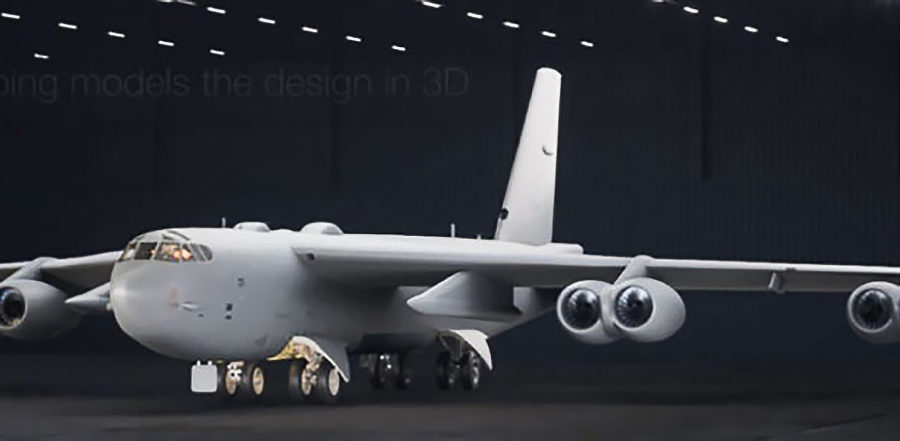Initial operational capability for the B-52J—the new designation for the bomber after extensive re-engining and upgrade programs—won’t be achieved until 2033. The three-year delay is due to issues both with its new engines and new radar, the Government Accountability Office said in a new report.
In its annual assessment of in-development weapons programs, released June 17, the GAO said funding shortfalls hampered timely completion of design for the B-52 Commercial Engine Replacement Program. As a result, the program won’t have a critical design review—and a contract award—until August 2025. That in turn pushed IOC to 2033, three years past the original plan and two years after a first delay was announced in 2022.
The delays result from the Air Force “underestimating the level of funding” needed to complete detailed design of the re-engining, which pairs Rolls Royce F130-200 engines with new nacelles, pylons, and controls. Boeing is the integrator of the project.
“Specifically, as the B-52 prototyping effort was extended from preliminary design to critical design, program officials received a proposal for the detailed design work,” the report states. “Program officials stated that the proposal cost exceeded the program’s available funding, and that they asked Boeing to slow its level of work to align with available funding. They also noted that an associated materials contract could not be awarded, causing additional delays.”
Other delays stemmed from a “best practices” effort to solicit input from pilots and maintainers while the design was progressing, GAO officials said.
“Program officials noted that this feedback led to design changes, such as a redesign of service panel hinges to improve maintainer access,” the report states. Though applauding this approach, the watchdog said “the program does not plan to conduct integrated, systems-level testing in an operational environment prior to production, which could provide additional knowledge into how key systems will perform and reduce production risk.”
Program managers told the GAO that the accelerated component and lab testing “will allow them to mitigate technical risks prior to the first production decision.” The contractors delivered a virtual systems prototype in the fall of 2023.
Last summer, program officials with the Air Force, Boeing, and Rolls Royce reported the program as being on-track. The GAO noted, however, that official new program costs had not been set by January, the close date for the data included in its report. This was because the program was in the process of transitioning from an accelerated, mid-tier acquisition to a major defense program.
The CERP effort plans to flight-test a production-representative prototype “about 6 months after the first low-rate initial production decision,” the report noted. “Officials stated that this approach presents cost risk, but they are willing to trade off cost risk in order to maintain schedule.”
Meanwhile, costs on the B-52 Radar Modernization Program jumped 12.6 percent last fall versus the 2021 estimate, and the program “declared a cost breach,” the report stated.
The RMP’s cost was estimated at $2.34 billion in 2021—inclusive of development and procurement—but by the end of fiscal 2023 had climbed to $2.58 billion.
The cost increase was attributed to buying more test hardware, staffing three integration laboratories, installing test gear, and “an additional year of contractor support,” but the principal technical issues involved “delays with the display and sensor processor.” A fiber optic line that was to allow the processors to talk to each other didn’t work, for example.
The B-52’s new radar is an adaptation and amalgam of those used on the Boeing F-15 and F/A-18. It uses the sensor from the F/A-18’s AN/APG-79V4, but pairs it with the processor in the APG-82 used on the F-15. Together, the two systems must fit within the space vacated by removing the B-52’s APG-166 analog radar system, which suffers from poor reliability, obsolescence, and parts scarcity. The new radar is expected to deliver vastly improved performance, both in operations and maintainability, and in both the conventional and nuclear roles. The new system—still lacking a name—will provide targeting information as well as weather and navigation aids.
Low-rate initial production of the RMP has slipped from late 2024 to spring 2025, with various elements of the project slipping from three to six months, the GAO report stated. This made the watchdog agency nervous because testing won’t be completed before low-rate initial production starts, and this typically leads to costly reworks if something is found not to work properly.
The RMP is supposed to achieve initial operating capability in 2027, well before the CERP. Program managers considered a two-stage designation for the combined upgrade: B-52I when the radars were installed, then B-52J once the new engines were added. The interim designation was dropped because the CERP was supposed to come close on the heels of the CERP. While that distinction may not seem very significant, a former program manager said “pilots need to know which kind of jet they’re stepping to; what to expect, and what [manual] to use.”
The overall B-52 upgrade also includes navigation and communication upgrades and structural improvements in some key areas. It is expected to extend the B-52 fleet’s life to the 2050s.
The Senate Armed Services Committee last week asked the Air Force to provide cost information for making the full fleet of 76 B-52s capable of nuclear operations. A portion of the fleet, under the New START treaty, lacks the hardening and wiring for that mission.
Elsewhere in the GAO’s report, it said the AGM-181 Long-Range Stand-Off missile—the nuclear weapon intended to succeed the AGM-86B Air-Launched Cruise Missile, carried only by the B-52—is still expected to achieve initial operational capability in 2030.
